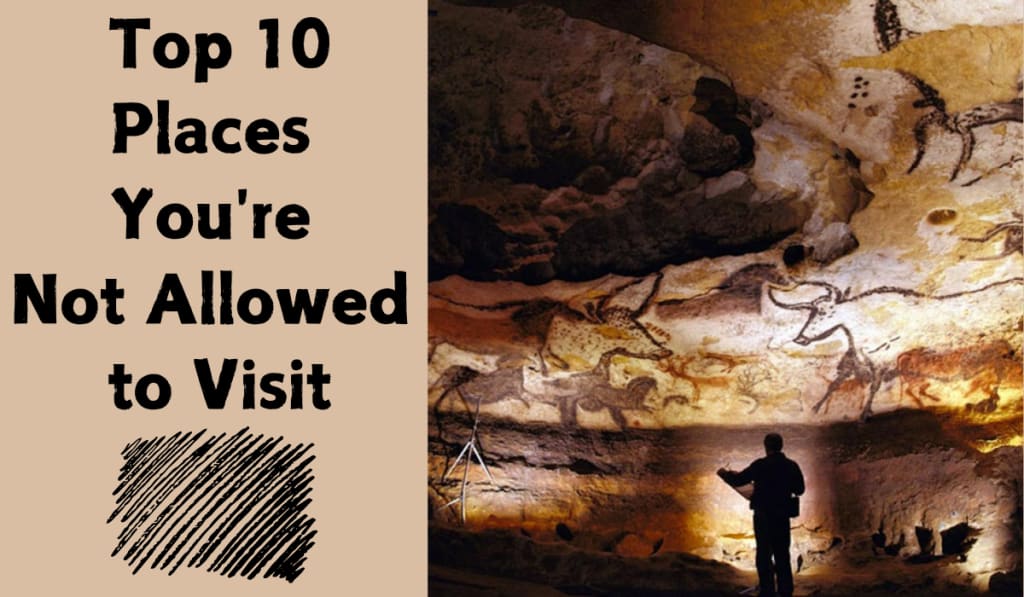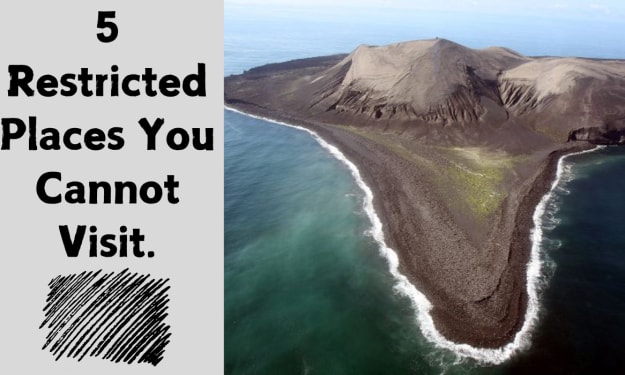Content warning
This story may contain sensitive material or discuss topics that some readers may find distressing. Reader discretion is advised. The views and opinions expressed in this story are those of the author and do not necessarily reflect the official policy or position of Vocal.
Discover the Forbidden Destinations
10 Places You're Not Allowed to Visit

The world is full of wonders, some of which are tantalisingly out of reach to the public. From ancient human settlements to dangerous natural formations, these forbidden places hold stories and secrets that only a few have witnessed firsthand. Are you ready to discover the unknown? Join me as we explore ten mysterious places you're not allowed to visit!
1. North Sentinel Island, India.
The Sentinelese live on North Sentinel Island, which is part of the Andaman and Nicobar Islands. They are one of the world's last uncontacted tribes. The Indian government maintains a five-mile exclusion zone around the island to protect Sentinelese from external diseases and preserve their way of life. Historically hostile to outsiders, the tribe has violently refused contact, resulting in fatalities. Two fishermen were killed in 2006 after drifting too close to the island, and in 2018, an American missionary suffered the same fate. The Indian Navy patrols the exclusion zone to ensure the Sentinelese's safety.
2. Maya Bay, Thailand.
Maya Bay on Koh Phi Phi Le island is famous for its breathtaking beauty, as seen in the 2000 film "The Beach" starring Leonardo DiCaprio. This cinematic fame resulted in an influx of tourists, which peaked at 1.2 million annually in 2015. The influx of tourists, combined with damage from the film's production, wreaked havoc on the fragile ecosystem. The coral reefs were destroyed, and the beach's pristine sands were littered with trash. In order to rehabilitate the area, the Thai government closed Maya Bay in 2019. A massive restoration project is currently underway, including coral planting and sand regeneration, with the goal of eventually reopening the bay under strict environmental regulations.
3. The Grand Shrine of Ise, Japan
The Grand Shrine of Ise, dedicated to the sun goddess Amaterasu, is Japan's most sacred Shinto shrine. Built with traditional techniques that do not use nails, the shrine is meticulously rebuilt every 20 years to honour Shinto beliefs in death and renewal. The current structure, completed in 2013, carries on this 2,000-year-old tradition. Only Shinto priests and members of the Japanese imperial family are allowed to enter the shrine. Visitors can, however, explore the tranquil grounds, which include ancient forests and beautifully crafted pathways dating back 150 years, providing insight into Japan's spiritual heritage.
4. Lascaux Caves, France.
In September 1940, 18-year-old Marcel Ravidat and his dog were exploring the countryside near Montignac when the animal fell into a hole. Ravidat descended into the cave with a group of friends and discovered the Lascaux Caves, one of the twentieth century's most significant archaeological finds. These caves are home to over 600 exquisite prehistoric paintings, including depictions of large animals such as aurochs, horses, and stags, as well as various enigmatic symbols. The site, which spans approximately 75 acres, opened to the public in 1948, but by 1963, it was clear that human activity was causing irreversible damage. Increased carbon dioxide levels and other contaminants promoted the growth of fungus and lichen, prompting authorities to close the caves. Today, only a few researchers have access, but detailed replicas and virtual reality experiences are available to the general public.
5. Morgan Island, USA.
Morgan Island, off the coast of South Carolina, is home to more than 3,500 rhesus monkeys. These monkeys were relocated from Puerto Rico in 1979 due to an outbreak of the herpes B virus, which posed a significant risk to humans. The island, which is now a research site managed by the National Institute of Allergy and Infectious Diseases (NIAID), is closed to the public to prevent disease transmission. Researchers pay visits under strict quarantine protocols to study the monkeys' behaviour and disease patterns in this isolated environment.
6. Uluru, Australia
Uluru, also known as Ayers Rock, is a massive sandstone monolith that rises 1,142 feet in Australia's Northern Territory. For thousands of years, the Anangu people have considered it a sacred site. Despite its spiritual significance, Uluru became a popular climbing destination during the 1930s. However, increased tourism resulted in significant physical and cultural damage. Uluru was officially closed to climbers in October 2019, following the approval of the Anangu people's request to ban it in 2017. Visitors can now enjoy its beauty from designated viewing areas and learn about its cultural significance at the nearby cultural centre.
7. Mezhgorye, Russia.
Mezhgorye, located in the southern Ural Mountains near Mount Yamantau, is one of Russia's most secretive communities. Established in 1979 and declared a town in 1995, it has approximately 16,000 residents who are all involved in top-secret military projects. Mezhgorye, believed to be the location of Russia's "Dead Hand" nuclear defence system, is heavily guarded. Unauthorised access is strictly prohibited, and approaching the town without permission could have serious consequences. The town's true purpose is shrouded in mystery, with speculation ranging from nuclear storage facilities to extraterrestrial research.
8. Pravcická Brana, Czech Republic.
Pravcicka Brana, in Bohemian Switzerland, is Europe's largest natural sandstone arch, standing 52 feet high and spanning 87 feet. Once a popular tourist destination, erosion concerns prompted a ban on walking across the arch in 1982. The arch is now only accessible from a distance, ensuring its structural integrity for future generations. Despite the restrictions, visitors can explore the nearby national park, which has breathtaking views and hiking trails that highlight the area's natural beauty.
9. Poveglia, Italy.
Poveglia, an island in the Venetian Lagoon, has a dark history as a plague quarantine station and then a mental asylum. The island has been abandoned since 1968 and is said to be haunted by the spirits of those who died on it. The soil is thought to contain remnants of past diseases, posing a potential biohazard. Strict penalties deter trespassers, protecting Venice from contamination. The island's eerie history and limited access have fueled numerous ghost stories, cementing its reputation as one of the world's most haunted places.
10. Heard Island, Australia.
Heard Island, located in the remote southern Indian Ocean, is one of the most isolated places on the planet. It has Australia's only active volcanoes, including Mawson Peak, the country's highest point at 9,006 feet. The island also has 41 glaciers and a diverse wildlife population, including seals and seabirds. Because of its fragility and ecological significance, the Australian government strictly regulates access. Only a few scientific expeditions have been permitted in recent decades, making it a once in a blue moon destination.
These forbidden places, whether for cultural, environmental, or safety reasons, are shrouded in mystery. While we may never visit these lands, their stories and efforts to preserve them evoke admiration and respect for the world's hidden treasures.
About the Creator
Elijah Eghenure
Hey there! I'm Elijah, the curious mind behind this blog. If you're here, you probably share my fascination with the futuristic and intriguing predictions and discoveries of our world today. Join in the adventure today!
Enjoyed the story? Support the Creator.
Subscribe for free to receive all their stories in your feed. You could also pledge your support or give them a one-off tip, letting them know you appreciate their work.






Comments (1)
I love reading this kind of interesting articles. Enjoyed it ❤️